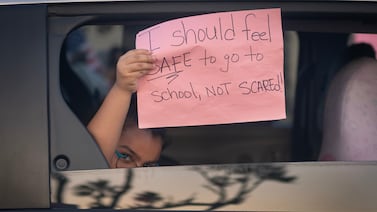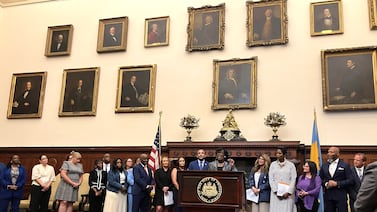Sign up for Chalkbeat Chicago’s free daily newsletter to keep up with the latest education news.
At least 150 Chicago Public Schools will have fewer staff positions next school year, according to a Chalkbeat analysis of school budget documents released by the district Tuesday.
The shifts in school staff are coming despite a new funding formula meant to more equitably fund schools and provide set staffing levels, as district leaders work to close a major budget deficit and grapple with the end of federal COVID relief money.
Still, district leaders said Tuesday that they’re optimistic about the new budget formula, and that CPS will guarantee a job elsewhere in the district for teachers who are losing their current positions due to budget cuts.
“The new budget model accomplishes what we set out to do: To provide more to our high needs schools with foundational resources that they haven’t had before,” CPS CEO Pedro Martinez told reporters during a press briefing on school budgets.
Officials have said the new formula is meant to support schools with more needs and those that have suffered for years from a vicious cycle of dwindling enrollment leading to less money and support.
The changes come as the district is projecting a $391 million deficit next fiscal year, which begins July 1. District officials had hoped for more money from the state. But a state budget deal passed by the Illinois Senate over the weekend does not provide the windfall to CPS that Mayor Brandon Johnson, district officials, and the teachers union lobbied for.
District officials have cautioned against comparing budgets year over year because of the new changed formula. They did not share dollar amounts associated with each budget.
Instead, the district released data showing how many staffers each school would get next year under the new formula, which provides a guaranteed number of staff — such as core teachers, principals, and assistant principals — and discretionary funding for all schools. The new formula then increases those resources based on a school’s need depending on multiple factors, such as the number of students from low-income backgrounds or the surrounding community’s characteristics.
District officials said they could not yet confirm Chalkbeat’s analysis. Mary Ann Fergus, a CPS spokesperson, said final spending amounts at schools will depend on who schools are able to hire and how staffing will change throughout the year. She added that the district expects to add a total of 200 more teachers next school year and will add several new positions, such as restorative justice coordinators for high-needs schools.
New budget formula’s impact on schools varies
The formula’s impact on school budgets depends on how you look at the data.
When comparing the new budget information for next year to staffing levels from last June, when the current school year budget was approved, 68% of district schools — or 339 — would see an increase of at least one part-time staffer. Another 32% — or close to 160 schools — would lose at least one part-time position.
But when comparing the newly proposed budgets to the latest staffing rosters as of March 30, more than half of district schools — 269 schools — would lose at least one part-time staffer, while another 41% — or 207 — would gain staffing. Another 27 schools would experience no change.
Martinez said budgets can change throughout the year as schools add and subtract positions.
When looking at March staffing levels — the most recent numbers available — Richard T. Crane Medical Prep High School on the city’s Near West Side would lose the most. Crane, which enrolled 264 students at the start of the school year, would lose about 14 of its nearly 60 staffers next year compared to this past March, according to Chalkbeat’s analysis.
On the flip side, Douglass High School in the west side neighborhood of Austin — where just 35 students were enrolled this year — would get the largest increase. It’s slated to add nine people to its staff of 23.
The budgets have been made public one month before the Chicago Board of Education is scheduled to vote to approve them. It also comes almost two months after Local School Councils started voting on individual school budgets — and after CPS denied multiple open records requests from Chalkbeat and other news outlets for school-by-school budget information.
The budget numbers the district released on Tuesday did not include information about the city’s roughly 120 charter schools, which serve about 50,000 students. It’s not clear how the district’s new approach to budgeting will affect those campuses and their staffing levels. Charters have long been funded through a per-student allocation.
The district’s shift to a new funding formula is “years” in the making, officials said. The old student-based budgeting formula was more squarely focused on student enrollment, with some increases for schools serving more students with high needs. Under that formula, schools received funding that principals could use flexibly to hire staff or pay for extra programming.
Now, schools will instead be allocated specific staff positions, plus additional discretionary funding that principals can use flexibly.
Martinez said the budgets for schools with “very low poverty rates” that have had many elective classes are “definitely tighter.” He said some of those schools had “very small class sizes” that were scrutinized sizes in order to “be responsible to our taxpayers.”
“It is those schools that have higher poverty, higher needs, they are definitely getting a lot more resources, but it’s not even just more resources,” Martinez said. “It’s actually frankly, finally setting the next best standard and a foundation that we have never had before.”
William Klee, CPS’s deputy chief of schools, said he’s heard from several principals at schools with “historic enrollment declines” that can “for the first time in recent memory” avoid cuts and increase programming. Klee added that principals “like that they can hire the best teacher for any position without worrying if they can afford the salary.”
School leaders share new formula’s pros and cons
Schools, including those in higher income neighborhoods, have reported losing staff for next school year. Others are anticipating more teachers and smaller class sizes, but are also seeing cuts to support staff, such as additional clerks. Thirty-seven schools that appealed their budgets ultimately received more teachers, district data shows.
One principal, who serves on a district school leader advisory group, said the district’s new formula left that leader’s school a few educators short of the number needed to avoid excessively large classes in some grades. But the principal, who spoke with Chalkbeat anonymously because the district had not authorized the interview, also said district officials provided extra positions once the school alerted them to the issue.
The principal said overall the new formula brings more clarity to the budgeting process. For instance, the approach clearly spells out the amount of discretionary dollars from a federal fund schools can use to recruit teachers and reduce class sizes — and how the district arrived at it. In previous years, the principal said that number sometimes wildly fluctuated from year to year.
“No one knew where that number came from,” the school leader said. “There was no rhyme or reason to it.”
But the proposed budgets have also come under criticism from some school leaders who say a loss of funding and positions will hurt distinctive programming.
In a letter sent to Martinez and other district leaders last week and shared with Chalkbeat, Kathleen Murphy, the head of the local school council at LaSalle II Magnet School, said the campus is slated to lose four out of its six foreign language teachers even as the school is still expected to offer four different language programs. That means the campus has to either significantly increase language class sizes, Murphy said, curtail its language offerings, or steer resources away from core classes such as math and reading.
“Decimating those language programs now, by taking away two-thirds of their funding, is doing untold damage to the educational programs LaSalle II and the other magnet world language academies have developed over the last 15-20 years,” Murphy wrote.
Correction: May 29, 2024: A previous version of this story misspelled the name of CPS’s deputy chief of schools. His name is William Klee.
Reema Amin is a reporter covering Chicago Public Schools. Contact Reema at ramin@chalkbeat.org.
Mila Koumpilova is Chalkbeat Chicago’s senior reporter covering Chicago Public Schools. Contact Mila at mkoumpilova@chalkbeat.org.







